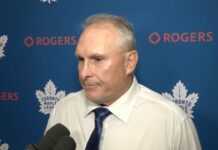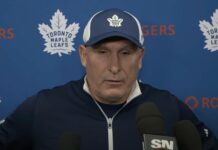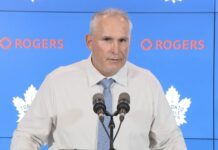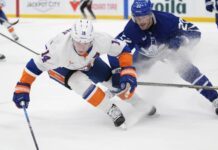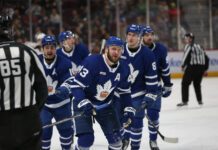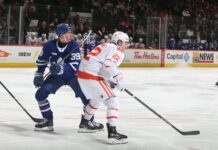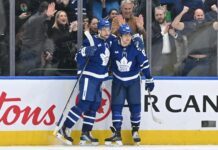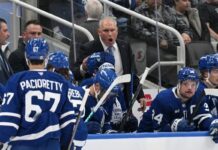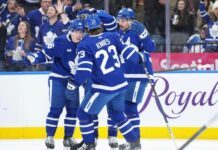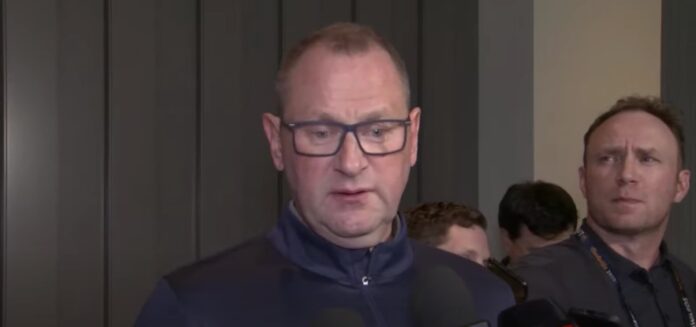
GM Brad Treliving joined Real Kyper and Bourne to discuss the news of John Klingberg’s season-ending surgery, his activity in the defense trade market, and the news of a rising cap projection to nearly $88 million for next season.
What was the process of getting to where you are now with John Klingberg?
Treliving: This goes back several weeks. John got to a point where he wasn’t able to play. We had some stops and starts with it. There are things you can play through, and there are things you can’t. There is a difference between being hurt and injured.
We looked at whether there was a way to patch it together. John would play a couple of games, miss a game, play a game, miss a couple of games. The decision was made to hit pause and see if some time away [would help] both from a rehab perspective and the process we were going through to see if John could be back playing and being effective. In the interim, we would look at the situation and what the options might be.
Ultimately, the decision was made that he has to have surgical intervention here. Certainly, it is disappointing. John is disappointed. He wanted to play. It is a big step whenever you have a surgical procedure.
In this case, you are talking about several months of rehab, effectively ending his season. John and the organization wanted to make sure we took all the time that was necessary to make the right decision. We got to that point.
Once you make the decision, you get on with the next steps of getting surgery set up, getting through that procedure, and going on to rehab.
We have seen Stanley Cup contenders place players on LTIR and then activate them for the playoffs. Eyebrows are raised. Nothing has come of it, but some people have accused Los Angeles or Tampa Bay of circumventing the cap. Is it important for GMs to air it out in terms of crossing their Ts and dotting their Is in a situation like this?
Treliving: I can’t speak to any other situation. LTI is there in a cap world where you have a player who is injured long-term. The player has to meet the criteria to fall under that designation.
In this case with John, there is no cuteness here. It is a player who will have a significant surgical procedure here. I don’t think anybody is going to get into trying to be cute and deal with a significant medical issue that way.
As there is with any rule or regulation, you have to go through your process. The league is always going to monitor these situations to ensure there is strict compliance, but at the end of the day, I would venture to say most times — and I can’t speak to all of the situations in other markets with other teams — when a player has gone on [LTIR] and missed significant time, there is a reason for it. Whether there is an injury that requires significant rehab or there is surgery, that is just the way it is.
I don’t think there is a lot of debate about any funny business going on here. If you go back — and there have been some in recent memory here — those players have had surgeries. They have significant medical issues.
Where the debate comes in is with players coming back and then you are effectively playing in the playoffs with a roster that exceeds the salary cap. There is no salary cap in the playoffs. There has been some debate about that issue over the last number of years, but it is pretty clear that for any player going on LTI, the league is very thorough about following up and ensuring that the player complies with the designation.
It is what it is. You have it there. The players that go on LTI are dealing with something of significance.
With the injuries on defense to Klingberg, Mark Giordano, and Timothy Liljegren, you have acknowledged your pursuit of outside help. One team that might be a trading partner is your former club, Calgary, with Noah Hanifin and Chris Tanev mentioned in the speculation. Do you think your history with Calgary would have any impact on their interest in trading with you? Is it a team whose players would be potentially available to you via trade?
Treliving: I am not going to comment on any other players on any players on any other teams. Never have and never will. I know there is always speculation.
As far as the situation in Calgary, I have a great relationship with the people there and the management team there. They are not unlike any other team that you deal with. Every team has the business that you are trying to complete. Not every situation is the same. It is none of my business to comment on what any other team is trying to do.
I made it clear coming into the season that we would like to see if we can help ourselves on defense. That is a great statement, but it is a matter of going out and doing it. This is certainly not making excuses, and it is the manager’s job to go and improve the team.
What I would say is that we have players who came in over the offseason, William Lagesson and Simon Benoit, who have done a really admirable job. They are getting better. They are big bodies. They have competed hard.
Certainly, with where our aspirations are as a team, we would like to improve the defense. It all comes at a cost. There just aren’t a lot of high-end defensemen that people are dying to give you for a low cost.
You look at the assets that you have in terms of potential trades. The team here has been trying to win and has spent some assets over the last couple of years, which is something teams trying to win do. That is normal course. That is what happens. You also have to be careful about how far you chase it and ultimately what the cost is you’re going to have to pay for someone to come in and make a significant difference.
We will continue to work that market. I am not making any headline statement here. We are no different than anybody else. Every team is trying to improve themselves at this time of the year.
It is an area where we were looking to help ourselves, and we have had a lot of injuries in that area. Players have come in who are deserving of a lot of credit for how they are playing. We are hopeful that help is on the way in the not-too-distant future with some of the players that are returning to health.
In the meantime, we will continue to look to see if there are ways to help ourselves at a cost that makes sense. The interesting part, when you look at the timing of it at this early stage of the year, is that you are talking about a lot of teams that are still trying to figure out what they are as a team and where they are going to sit. We are a long way away from the trade deadline.
We still have a lot of runway. It is early in the season. We are just past the 20-game mark. We will continue to work on it and see if there is a way to improve an area where we would like to improve.
The salary cap is projected toward $88 million next year. Is that a good and bad case scenario — good that you have more money to spend, but bad that you have to give it all to William Nylander?
Treliving: It is good news that there is going to be growth. All teams have gone through a stagnant cap, for lack of a better term. There hasn’t been any growth as we have gone through the last several years. To be in a position where there is growth is a positive thing for sure.
Certainly, we have Willy to sign. I have stated it any time I have been asked. Our sole objective is to try to get him signed. We continue to work at it.
Apart from that, we have decisions to make elsewhere. We will continue to balance it — as we talk about the now concerning the defense and the injury with John — while knowing what’s coming on the books next year and what the cap situation is.
We will continue to work on that puzzle. We will be happy with any increase. The fact that the cap is moving up is a positive thing. Now it’s our job to figure out how to best utilize it.


